What are the gaps and challenges in the current management of patients presenting with chest pain in the ED at IJN? What were the key motivations that led to the implementation of the hs-TnT 0/1-hr rapid algorithm?
IJN is unique in that most of our patients come with cardiac related issues. Therefore, the volume of our patients with such presentation is quite high, compared to other hospitals. We do have challenges in managing patients with chest pain in the Emergency Department (ED) because they can come with a varying type of chest pain complaints as well as risk factor backgrounds. There are also issues of overcrowding in the ED as patients may not be managed as efficiently as they could due to turnaround times of investigations and also decision making by the doctors. The gaps that we identified are that we were currently not using a validated algorithm for management of chest pain patients at the ED.
Based on key updates from the European Society of Cardiology Guidelines, they have recommended the use of this 0/1-hr rapid algorithm using high-sensitivity Troponin T (hs-TnT) for patients who present with chest pain to the ED. As a premier heart center, we felt that we needed to implement this algorithm at our center as there is high expectation from patients who come to us with presentation of chest pain. So we need to manage them safely or either we need to admit or discharge them. These were the main motivators for us to implement this new 0/1-hr rapid algorithm in the management of our chest pain patients. The doctors also feel that it is safer to use a validated algorithm that is practiced internationally.
How is the 0/1-hr rapid algorithm being adopted in IJN?
Patients who come to the ED with chest pain can be quite variable in terms of when they had the chest pain and also the nature of the chest pain and their risk factors as well. So when they come to the ED, we would like to have a standardized management for these patients. And so this is why we wanted to implement the 0/1-hr rapid algorithm.
Ideally, when a patient comes with chest pain, one of the first things that we actually want to do is an ECG, which is the electrocardiogram. This will tell us immediately if the patient is having an acute heart attack or not. And then we can manage the patient accordingly if the patient is having an acute heart attack. Besides performing an electrocardiogram (ECG), we perform blood tests at the time that they arrive which is the 0 hour, and repeat it after 1 hour, which is the 1hr hs-TnT blood test. And the doctor is able to review these results in an efficient manner.
With this validated algorithm, it actually categorizes the patients into a rule in, a rule out or an observed category. So patients with low risk, who have a very low level of hs-TnT, we’re actually able to discharge them safely and rule out a Myocardial Infarction (MI) or a heart attack. For patients with above a certain cutoff value, which is a high level of hs-TnT, we are able to rule in a MI using the algorithm. And these patients are admitted and treated as a MI where they are being given treatment, such as blood thinners. For those in the observed category, the doctor is able to perform further tests to decide on whether the patient is safe for discharge or requires an admission as well. So putting all these into practice, the doctor will then make the best decision for managing the patients.
What did the implementation journey of the rapid algorithm look like? How was the lab a key partner in the success of the adoption?
Prior to using the 0/1-hr rapid algorithm, we found that there was not much standardization in the way the doctors manage patients with chest pain. So we thought that using this algorithm would provide a safe method in which the doctor would manage and make decisions for patients. The other thing is that with the 0/1-hr rapid algorithm, patients are managed more efficiently because the decision will come a lot quicker, as they are just following an algorithm on whether the patient requires admission or is safe to be discharged. So we believe that this enhances patient safety as well as enhances the patient’s experience in their journey when they come to the ED with chest pain.
To start off this implementation, in the pre implementation phase, it was necessary to look at the entire patient journey for these patients with chest pain. And we did this through several workshops. One is to look at the entire patient journey and identify the gaps. And another, multidisciplinary team workshop, to work with our key partners, the laboratory team, and to identify the gaps in each other’s processes and to understand each other’s processes better so that we can work together to make this implementation a success.
For this transformation to happen, the Lab was indeed a very important partner for us. Why? Because we were reliant on them to process the hs-TnT with a turnaround time that is efficient and recommendations are that this is done in 1 hour. With this, the doctors are able to review the results quickly and make efficient decisions for the patients that they see in the ED. So we had to work very closely with our laboratory team to make this happen.
What have been some of the major outcomes and improvements in patients care since the implementation of the rapid algorithm?
From the clinicians’ perspective, I think the doctors feel more confident in managing their patients safely. When using this validated algorithm, they know that they are following international guidelines, in terms of admitting or discharging patients. And they know that they are following a clear process and that the patient safety is maintained. We feel that the patients are managed more efficiently, especially when they are having blood samples taken from them 1 hour apart and with a good turnaround time from the lab that we are able to review them and not make them wait long and they are reassured that we are using international guidelines in managing their chest pain.
In terms of the hospital’s perspective, we want to practice efficiency. That means when we make a decision for the patient such as an admission, we want to make it quickly and ensure that the patient gets to the ward to receive further treatment. So this improves the efficiency and throughput of patients in the ED. So they don’t have to wait long in the ED for a decision to be made for them to be admitted. I think this, in terms of hospital management is quite crucial, as we do not want any overcrowding in the ED. Also in terms of patient complaints, we’ve seen a reduction in waiting time as well as there’s no complaints about how patients are managed with regards to chest pain.
How does the rapid algorithm align with other advancements or innovations being used in healthcare and patient management at IJN Malaysia?
IJN is a 24-hour heart attack center. We have interventions such as angiogram and what we call a percutaneous coronary intervention, which is if there is blockage in a patient’s heart vessel, we are able to address that immediately at the catheterization lab. This aligns with that in the sense that patients who do not have an acute heart attack but may have a different form of heart attack, let’s say a myocardial heart muscle damage. Then this allows the cardiologist to decide on how soon they want to perform an angiogram for the patient. So this is like a risk stratification as well for them.
If your hs-TnT are in the thousands, you may want to prioritize these patients to receive this intervention, along with assessing their symptoms or any changes in the ECG. This aligns very much with the overall management of patients with heart disease in IJN.
What advice or insights would you give to other healthcare institutions or professionals looking to implement rapid algorithms to improve patient outcomes?
Based on international guidelines, there are some other recommendations as well, such as a 0/2-hr and 0/3-hr. But the 0/1-hr has received a level one recommendation from the International Cardiac Societies. And therefore we feel that if there is a most efficient method or algorithm to use that has proven to be safe, then I think this is worth implementing in other hospitals as well. But to implement this, I would advise that you need to work very closely with your key partners and also identify your patient journey process that is localized to your own ED, and see where the gaps are, and to address those as a whole, before implementing this 0/1-hr rapid algorithm.
Looking ahead, what are the long-term goals and aspirations of IJN Malaysia in terms of leveraging technology for better triage and improving patient care?
IJN aims to be a center of excellence. Specifically to our department, we want to be a center of excellence in cardiac emergency. Not only would we like to use technology and the latest treatments available in diagnosis and management of patients with cardiac problems, we also want to look at our data and our processes to ensure that there’s efficiency. In looking at the data, we want to ensure that we are continuously improving processes within the ED and also working very closely with our cardiologists in using the latest technology to manage patients.

















